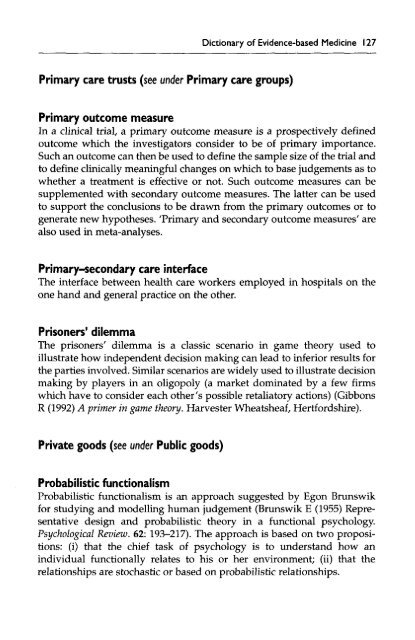Dictionary of Evidence-based Medicine.pdf
Dictionary of Evidence-based Medicine.pdf
Dictionary of Evidence-based Medicine.pdf
Create successful ePaper yourself
Turn your PDF publications into a flip-book with our unique Google optimized e-Paper software.
<strong>Dictionary</strong> <strong>of</strong> <strong>Evidence</strong>-<strong>based</strong> <strong>Medicine</strong> 127<br />
Primary care trusts (see under Primary care groups)<br />
Primary outcome measure<br />
In a clinical trial, a primary outcome measure is a prospectively defined<br />
outcome which the investigators consider to be <strong>of</strong> primary importance.<br />
Such an outcome can then be used to define the sample size <strong>of</strong> the trial and<br />
to define clinically meaningful changes on which to base judgements as to<br />
whether a treatment is effective or not. Such outcome measures can be<br />
supplemented with secondary outcome measures. The latter can be used<br />
to support the conclusions to be drawn from the primary outcomes or to<br />
generate new hypotheses. 'Primary and secondary outcome measures' are<br />
also used in meta-analyses.<br />
Primary-secondary care interface<br />
The interface between health care workers employed in hospitals on the<br />
one hand and general practice on the other.<br />
Prisoners' dilemma<br />
The prisoners' dilemma is a classic scenario in game theory used to<br />
illustrate how independent decision making can lead to inferior results for<br />
the parties involved. Similar scenarios are widely used to illustrate decision<br />
making by players in an oligopoly (a market dominated by a few firms<br />
which have to consider each other's possible retaliatory actions) (Gibbons<br />
R (1992) A primer in game theory. Harvester Wheatsheaf, Hertfordshire).<br />
Private goods (see under Public goods)<br />
Probabilistic functionalism<br />
Probabilistic functionalism is an approach suggested by Egon Brunswik<br />
for studying and modelling human judgement (Brunswik E (1955) Representative<br />
design and probabilistic theory in a functional psychology.<br />
Psychological Review. 62: 193-217). The approach is <strong>based</strong> on two propositions:<br />
(i) that the chief task <strong>of</strong> psychology is to understand how an<br />
individual functionally relates to his or her environment; (ii) that the<br />
relationships are stochastic or <strong>based</strong> on probabilistic relationships.










